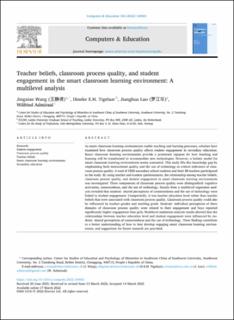| dc.contributor.author | Wang, Jingxian | |
| dc.contributor.author | Tigelaar, Dineke | |
| dc.contributor.author | Luo, Jianghua | |
| dc.contributor.author | Admiraal, Wilfried | |
| dc.date.accessioned | 2023-07-07T08:37:30Z | |
| dc.date.available | 2023-07-07T08:37:30Z | |
| dc.date.created | 2022-04-09T08:32:00Z | |
| dc.date.issued | 2022 | |
| dc.identifier.issn | 0360-1315 | |
| dc.identifier.uri | https://hdl.handle.net/11250/3077056 | |
| dc.description.abstract | As smart classroom learning environments enable teaching and learning processes, scholars have examined how classroom process quality affects student engagement in secondary education. Smart classroom learning environments provide a prominent signpost for how teaching and learning will be transformed to accommodate new technologies. However, a holistic model for smart classroom learning environments seems warranted. This study fills this knowledge gap by emphasizing both instructional quality and the use of technology as critical indicators of classroom process quality. A total of 1825 secondary school students and their 38 teachers participated in the study. By using teacher and student questionnaires, the relationship among teacher beliefs, classroom process quality, and student engagement in smart classroom learning environments was investigated. Three components of classroom process quality were distinguished: cognitive activation, connectedness, and the use of technology. Results from a multilevel regression analysis revealed that students' shared perceptions of connectedness and the use of technology were linked to student engagement. Unexpectedly, it was teacher education level rather than teacher beliefs that were associated with classroom process quality. Classroom process quality could also be influenced by teacher gender and teaching grade. Students' individual perceptions of three domains of classroom process quality were related to their engagement and boys reported significantly higher engagement than girls. Multilevel mediation analysis results showed that the relationships between teacher education level and student engagement were influenced by students' shared perceptions of connectedness and the use of technology. These findings contribute to a better understanding of how to best develop engaging smart classroom learning environments, and suggestions for future research are provided. | en_US |
| dc.language.iso | eng | en_US |
| dc.rights | Navngivelse 4.0 Internasjonal | * |
| dc.rights.uri | http://creativecommons.org/licenses/by/4.0/deed.no | * |
| dc.title | Teacher beliefs, classroom process quality, and student engagement in the smart classroom learning environment: A multilevel analysis | en_US |
| dc.type | Journal article | en_US |
| dc.type | Peer reviewed | en_US |
| dc.description.version | publishedVersion | en_US |
| cristin.ispublished | true | |
| cristin.fulltext | original | |
| cristin.qualitycode | 2 | |
| dc.identifier.doi | 10.1016/j.compedu.2022.104501 | |
| dc.identifier.cristin | 2016305 | |
| dc.source.journal | Computers & Education | en_US |
| dc.source.volume | 183 | en_US |

